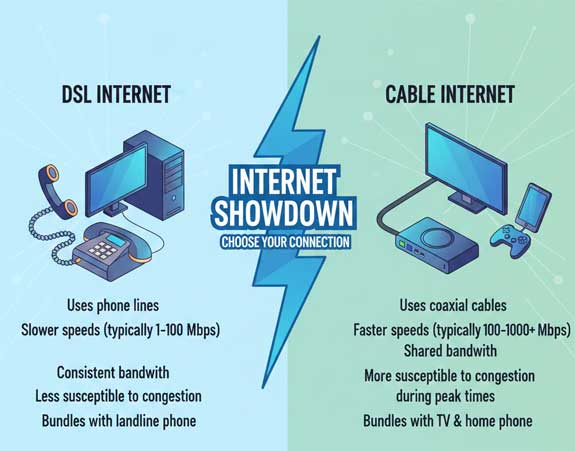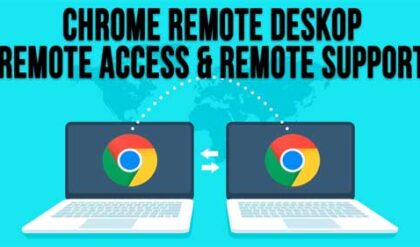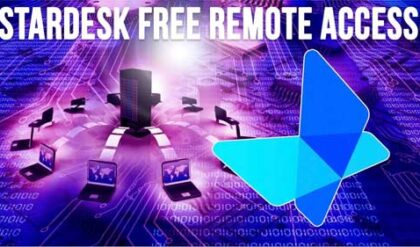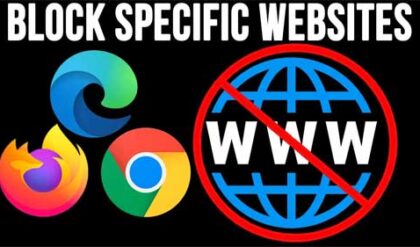High speed Internet or broadband Internet as it’s commonly referred to lets you surf the web and download files at much higher speeds than you could back when your only choice was a dial-up connection going through your analog phone line connection. Plus broadband Internet is always on so there is no need to dial a number and wait for it to connect.
High speed Internet is becoming more popular and more available recently and almost everyone has an opinion on which is faster and more reliable. The days of dial-up are quickly fading away as broadband prices are dropping as companies are competing for your business. But which type of Internet access should you choose? Both will offer you high-speed reliable Internet access but there are a few differences between the two. Another factor for intenret speed is your web hosting company. Getting a top web hosting company can put a web site above the rest.

Features
DSL (Digital Subscriber Line) technology provides high speed, broadband Internet connections to homes and small businesses. DSL uses the same cabling used for telephones, but at higher data rates. DSL uses what is called digital modem technology and users share the same line for their digital and analog traffic. With DSL you can do voice and fax communication at the same time as data communication. DSL maxes out at about 3.5 miles from a telephone exchange. The further you are from your DSL service provider’s facilities, the lower the speed you will get. DSL service currently requires that you have a local telephone line.
A cable modem is a device that attaches to your cable TV network connection and then to your computer. The use of a cable modem does not affect your cable TV reception and you do not need to subscribe to cable TV service in order to have cable Internet. One down size to cable modem service is that it involves locally shared bandwidth. This means the realized performance of your Internet will depend on how many other customers in your local area subscribe to the same service. Local cable Internet providers have enough bandwidth in your area that can handle a lot of users. Unlike DSL, you receive the same rate of speed no matter what distance you are from your provider. Cable is generally more popular but DSL gaining ground.
Speed
Generally cable has an advantage over DSL when it comes to speed. However, cable does not always deliver and speeds may be inconsistent. Most cable providers offer service with between 5 Mbps and 30 Mbps of bandwidth. The speed of DSL ranges from 1.5 Mbps to 20 Mbps. With newer fiber optic connections, the speeds are even higher. DSL offers more than 100 times the network performance of a traditional dial-up modems.
Cable technology supports a maximum of approximately 30 Mbps of bandwidth, whereas most forms of DSL cannot reach more than 20 Mbps. DSL and cable Internet providers often implement “speed caps” that limit the bandwidth of their services to create a fair distribution of bandwidth of customers.
Security
Essentially, all cable customers in the region belong to the same network and are more vulnerable to network attacks from users on that same network. Many providers avoid this problem today by bundling security features in the cable modem hardware. DSL on the other hand uses dedicated rather than shared cabling, and DSL customers in a given neighborhood do not appear as nodes on a shared network.
DSL and cable connections are “always on” meaning that if your computer is on and plugged into your modem then you are always online and may be more vulnerable to attacks because of that. Many DSL and cable modem customers install routers/firewalls to protect their internal systems. A DSL or cable router enhances the functionality of the basic modem with security features such as packet filtering and hiding your computer from the outside world (network).
Price
DSL tends to be cheaper than cable and you can always find special introductory pricing on either one.
DSL – $30-50/month with higher prices for business (usually $60 and up a month)
Cable – $40-50/month
Both usually have installation fees involved unless you do it yourself.
Summary
When choosing a high-speed Internet connection you should base your decision on how fast you need to go and how much you want to pay. Before committing to a contract check to make sure they guarantee the advertised speeds and see if you can find out any data on their reliability (up time). Also make sure you know how long the contract is for and how much it will cost to get out of it if you need to. It’s also good to see if they have a trial period so you can see if you like it before committing.
For additional training resources, check out our online IT training courses.
Check out our extensive IT book series.






